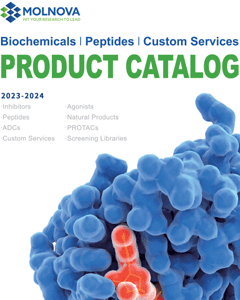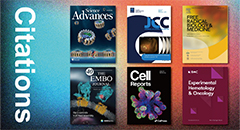
Benzenebutyric acid
CAS No. 1821-12-1
Benzenebutyric acid ( 4-Phenylbutyric acid )
产品货号. M20554 CAS No. 1821-12-1
苯丁酸是 HDAC 的抑制剂,也是一种抗肿瘤剂。
纯度: >98% (HPLC)
 COA
COA
 Datasheet
Datasheet
 HNMR
HNMR
 HPLC
HPLC
 MSDS
MSDS
 Handing Instructions
Handing Instructions
| 规格 | 价格/人民币 | 库存 | 数量 |
| 500MG | ¥332 | 有现货 |


|
| 1G | 获取报价 | 有现货 |


|
生物学信息
-
产品名称Benzenebutyric acid
-
注意事项本公司产品仅用于科研实验,不得用于人体或动物的临床与诊断
-
产品简述苯丁酸是 HDAC 的抑制剂,也是一种抗肿瘤剂。
-
产品描述Benzenebutyric acid is an inhibitor of HDACand is an antineoplastic agent.(In Vitro):4-Phenylbutyric acid (4-PBA) is an inhibitor of HDAC, inhibits the growth of NSCLC Cell Lines at 2 mM. Benzenebutyric acid in combination with ciglitizone results in enhanced growth arrest of cancer cells. 4-Phenylbutyric acid (0-5 mM) inhibits ASFV infection in a dose-dependent manner. Benzenebutyric acid also inhibits the ASFV late protein synthesis and disrupts the virus-induced H3K9/K14 hypoacetylation status. Benzenebutyric acid and enrofloxacin act synergistically to abolish ASFV replication. Addition of bafilomycin A1 results in accumulation of LC3II, whereas 4-Phenylbutyric acid substantially reduces this accumulation. LPS decreases the level of p62, whereas Benzenebutyric acid reverses this decrease upon LPS stimulation for 48 h. The percentage of cells with LPS-induced AVOs is increased at 48 h, whereas 4-Phenylbutyric acid significantly reduces this percentage. Specifically, the percentage of cells with AVOs decreases from 61.6% to 53.1% upon Benzenebutyric acid treatment, supporting that 4-Phenylbutyric acid inhibits LPS-induced autophagy. As a positive control for autophagy inhibition, bafilomycin A1 is used. The percentage of cells with LPS-induced AVOs is reduced by bafilomycin A1 treatment. The decreased OC area and fusion index observed after Benzenebutyric acid treatment are not observed with knockdown of ATG7. Inhibition of NF-κB using BAY 11-7082 and JSH23 reduce the LC3 II level upon LPS stimulation and completely abolish the inhibitory effect of Benzenebutyric acid on LPS-induced effects. (In Vivo):LPS induces significant bone loss and decreases bone mineral density (BMD), bone volume (BV/TV), and trabecular thickness (Tb. Th) compared with PBS alone, whereas trabecular space (Tb. Sp.) is increased. 4-Phenylbutyric acid (4-PBA) attenuates LPS-induced bone loss. Treatment with 4-Phenylbutyric acid increases BMD, BV/TV, and Tb. Th. compared with LPS alone, in addition to decreasing the enlargement of Tb. Sp., but no change is observed when mice are treated with Benzenebutyric acid alone. OC.S/BS as assessed by TRAP staining is also significantly reduced when Benzenebutyric acid is administered to LPS-treated mice. However, OC.N/BS tends to decrease, although not with statistical significance, when mice are treated with Benzenebutyric acid and LPS. These results indicate that the effect of Benzenebutyric acid on OC from LPS-treated mice is to reduce its size rather than number. Consistent with these findings, a marker of bone resorption in vivo, serum CTX-1 which is elevated by LPS treatment is decreased when Benzenebutyric acid administered to LPS-injected mice. However, co-treatment with Benzenebutyric acid do not significantly affect the levels of serum ALP and osteocalcin, 2 markers of bone formation in vivo, compared with LPS alone. Benzenebutyric acid also reduces the LPS-induced rise in serum MCP-1, indicating that Benzenebutyric acid decreases systemic inflammation induced by LPS.
-
体外实验4-Phenylbutyric acid (4-PBA) is an inhibitor of HDAC, inhibits the growth of NSCLC Cell Lines at 2 mM. Benzenebutyric acid in combination with ciglitizone results in enhanced growth arrest of cancer cells. 4-Phenylbutyric acid (0-5 mM) inhibits ASFV infection in a dose-dependent manner. Benzenebutyric acid also inhibits the ASFV late protein synthesis and disrupts the virus-induced H3K9/K14 hypoacetylation status. Benzenebutyric acid and enrofloxacin act synergistically to abolish ASFV replication. Addition of bafilomycin A1 results in accumulation of LC3II, whereas 4-Phenylbutyric acid substantially reduces this accumulation. LPS decreases the level of p62, whereas Benzenebutyric acid reverses this decrease upon LPS stimulation for 48 h. The percentage of cells with LPS-induced AVOs is increased at 48 h, whereas 4-Phenylbutyric acid significantly reduces this percentage. Specifically, the percentage of cells with AVOs decreases from 61.6% to 53.1% upon Benzenebutyric acid treatment, supporting that 4-Phenylbutyric acid inhibits LPS-induced autophagy. As a positive control for autophagy inhibition, bafilomycin A1 is used. The percentage of cells with LPS-induced AVOs is reduced by bafilomycin A1 treatment. The decreased OC area and fusion index observed after Benzenebutyric acid treatment are not observed with knockdown of ATG7. Inhibition of NF-κB using BAY 11-7082 and JSH23 reduce the LC3 II level upon LPS stimulation and completely abolish the inhibitory effect of Benzenebutyric acid on LPS-induced effects.
-
体内实验LPS induces significant bone loss and decreases bone mineral density (BMD), bone volume (BV/TV), and trabecular thickness (Tb. Th) compared with PBS alone, whereas trabecular space (Tb. Sp.) is increased. 4-Phenylbutyric acid (4-PBA) attenuates LPS-induced bone loss. Treatment with 4-Phenylbutyric acid increases BMD, BV/TV, and Tb. Th. compared with LPS alone, in addition to decreasing the enlargement of Tb. Sp., but no change is observed when mice are treated with Benzenebutyric acid alone. OC.S/BS as assessed by TRAP staining is also significantly reduced when Benzenebutyric acid is administered to LPS-treated mice. However, OC.N/BS tends to decrease, although not with statistical significance, when mice are treated with Benzenebutyric acid and LPS. These results indicate that the effect of Benzenebutyric acid on OC from LPS-treated mice is to reduce its size rather than number. Consistent with these findings, a marker of bone resorption in vivo, serum CTX-1 which is elevated by LPS treatment is decreased when Benzenebutyric acid administered to LPS-injected mice. However, co-treatment with Benzenebutyric acid do not significantly affect the levels of serum ALP and osteocalcin, 2 markers of bone formation in vivo, compared with LPS alone. Benzenebutyric acid also reduces the LPS-induced rise in serum MCP-1, indicating that Benzenebutyric acid decreases systemic inflammation induced by LPS.
-
同义词4-Phenylbutyric acid
-
通路Cell Cycle/DNA Damage
-
靶点HDAC
-
受体HDAC
-
研究领域Metabolic Disease
-
适应症Maple Syrup Urine Disease
化学信息
-
CAS Number1821-12-1
-
分子量164.2
-
分子式C10H12O2
-
纯度>98% (HPLC)
-
溶解度DMSO:125 mg/mL (761.27 mM)
-
SMILESOC(=O)CCCc1ccccc1
-
化学全称4-Phenylbutyric acid
运输与储存
-
储存条件(-20℃)
-
运输条件With Ice Pack
-
稳定性≥ 2 years
参考文献
1.Tsg-Hui C Eva S . Enhanced growth inhibition by combination differentiation therapy with ligands of peroxisome proliferator-activated receptor-gamma and inhibitors of histone deacetylase in adenocarcinoma of the lung[J]. Clinical Cancer Research 2002 8(4):1206-1212.



 021-51111890
021-51111890 购物车()
购物车()
 sales@molnova.cn
sales@molnova.cn











